Related Research Articles

A cable car is a type of cable railway used for mass transit in which rail cars are hauled by a continuously moving cable running at a constant speed. Individual cars stop and start by releasing and gripping this cable as required. Cable cars are distinct from funiculars, where the cars are permanently attached to the cable.
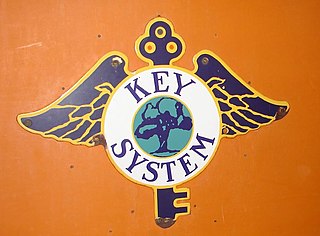
The Key System was a privately owned company that provided mass transit in the cities of Oakland, Berkeley, Alameda, Emeryville, Piedmont, San Leandro, Richmond, Albany, and El Cerrito in the eastern San Francisco Bay Area from 1903 until 1960, when it was sold to a newly formed public agency, AC Transit. The Key System consisted of local streetcar and bus lines in the East Bay, and commuter rail and bus lines connecting the East Bay to San Francisco by a ferry pier on San Francisco Bay, later via the lower deck of the Bay Bridge. At its height during the 1940s, the Key System had over 66 miles (106 km) of track. The local streetcars were discontinued in 1948 and the commuter trains to San Francisco were discontinued in 1958. The Key System's territory is today served by BART and AC Transit bus service.
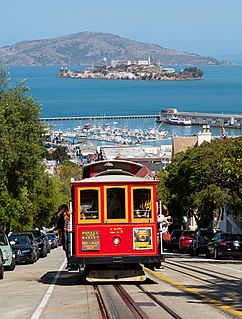
The San Francisco cable car system is the world's last manually operated cable car system. An icon of San Francisco, the cable car system forms part of the intermodal urban transport network operated by the San Francisco Municipal Railway. Of the 23 lines established between 1873 and 1890, only three remain : two routes from downtown near Union Square to Fisherman's Wharf, and a third route along California Street. While the cable cars are used to a certain extent by commuters, the vast majority of the millions of passengers who use the system every year are tourists, and as a result, the wait to get on can often reach two hours or more. They are among the most significant tourist attractions in the city, along with Alcatraz Island, the Golden Gate Bridge, and Fisherman's Wharf.
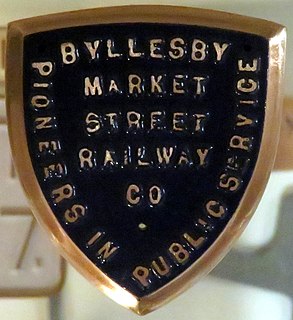
The Market Street Railway Company was a commercial streetcar and bus operator in San Francisco. The company was named after the famous Market Street of that city, which formed the core of its transportation network. Over the years, the company was also known as the Market Street Railroad Company, the Market Street Cable Railway Company and the United Railroads of San Francisco.

The Northwestern Pacific Railroad is a railroad covering the 62 mi (100 km) stretch between Schellville and Windsor with freight and Sonoma–Marin Area Rail Transit (SMART) commuter trains. Formerly, it was a regional railroad that served the entire North Coast of California, with a main line running 271 miles (436 km) from Schellville to Eureka, along with an additional portion of the line running from the Ignacio Wye to the edge of San Rafael. The portion of the NWP main line between the Ignacio Wye in Marin County and the depot in Healdsburg is owned by SMART. The Schellville–Ignacio and Healdsburg–Eureka portions are owned by the North Coast Railroad Authority (NCRA). Private contractor NWPco operates freight service under NCRA lease. California's 2018 Great Redwood Trail Act repurposes the abandoned railroad right-of-way from Eureka to the San Francisco Bay in Marin County for future use as the "Great Redwood Trail" rail-trail.

The Western Railway Museum, in Solano County, California is located on Highway 12 between Rio Vista and Suisun. The museum is built along the former mainline of the Sacramento Northern Railway. Their collection focuses on trolleys, as it is primarily a museum of interurban transit equipment.

The Central California Traction Company is a Class III short-line railroad operating in the northern San Joaquin Valley, in San Joaquin County, California. It is owned jointly by the Union Pacific and BNSF Railway.

The Modesto and Empire Traction Company is a Class III short-line railroad operating in California's San Joaquin Valley. It is owned by the Beard Land & Investment Company; the Beard family has always owned the railroad. The Beards also created the Beard Industrial Park where the MET's customers are located. The railroad was unique in that it had operated for nearly 50 years exclusively with GE 70-ton switchers built between 1947 and 1955; however, a former Southern Pacific EMD SW1500 switcher was added to the roster as of late). The MET operates on 5 miles (8 km) of mainline track, as well as an additional 48.7 miles (78.4 km) of yard and industry track, providing switching services in the Beard Industrial Park. The MET interchanges with the Union Pacific at Modesto and with the BNSF Railway Stockton Subdivision at Empire.
The Oakland Terminal Railway was a terminal railroad in West Oakland, California. The OTR was jointly acquired in 1943 by the Western Pacific Railroad and Atchison, Topeka and Santa Fe Railway to take over the Key System's freight railroad known as the Oakland Terminal Railroad. Today, the OTR is now the West Oakland Pacific Railroad that operates on 10 miles of track. OTR was jointly owned by the Union Pacific Railroad and BNSF Railway. The railroad operated in the industrial area around the Oakland Army Base.

The Sacramento Northern Railway was a 183-mile (295 km) electric interurban railway that connected Chico in northern California with Oakland via the California capital, Sacramento. In its operation it ran directly on the streets of Oakland, Sacramento, Yuba City, Chico, and Woodland and ran interurban passenger service until 1941 and freight service into the 1960s.

The Tidewater Southern Railway was a short line railroad in Central California in the United States. For most of its history, it was a subsidiary of the Western Pacific Railroad. It was originally built as an interurban system, connecting to the Central California Traction Company, Western Pacific Railroad, Southern Pacific Railroad and Atchison, Topeka and Santa Fe Railway in Stockton, California. Its mainline went southeast from Stockton to Escalon, California and thence to Modesto, California before splitting into two branches ending at the towns of Turlock and Hilmar. Until the mid-1930s, there were plans to extend the line to Fresno and even toward the Los Angeles area. Today, much of the line is still operated by the Union Pacific Railroad. Of all the former interurban railroads in California, the former Tidewater Southern retains the highest percentage of still operating trackage.
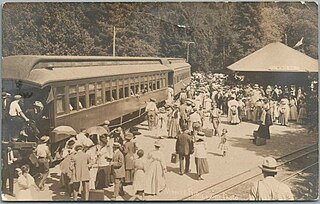
The North Pacific Coast Railroad (NPC) was a common carrier 3 ft narrow-gauge steam railroad begun in 1874 and sold in 1902 to new owners who renamed it the North Shore Railroad (California) (NSR) and which rebuilt the southern section into a standard-gauge electric railway.

San Francisco Bay in California has been served by ferries of all types for over 150 years. John Reed established a sailboat ferry service in 1826. Although the construction of the Golden Gate Bridge and the San Francisco–Oakland Bay Bridge led to the decline in the importance of most ferries, some are still in use today for both commuters and tourists.
The Indiana Railroad (IR) was the last of the typical Midwestern United States interurban lines. It was formed in 1930-31 by combining the operations of the five major interurban systems in central Indiana into one entity. The predecessor companies came under the control of Midland Utilities, owned by Samuel Insull. His plan was to modernize the profitable routes and abandon the unprofitable ones. With the onset of the Great Depression, the Insull empire collapsed and the Indiana Railroad was left with a decaying infrastructure and little hope of overcoming the growing competition of the automobile for passenger business and the truck for freight business. The IR faced bankruptcy in 1933, and Bowman Elder was designated as the receiver to run the company. Payments on bonded debt were suspended. Elder was able to keep the system virtually intact for four years, and IR operated about 600 miles (970 km) of interurban lines throughout Indiana during this period. During the late 1930s, the routes were abandoned one by one until a 1941 wreck with fatalities south of Indianapolis put an abrupt end to the last operation of interurbans in Indiana.
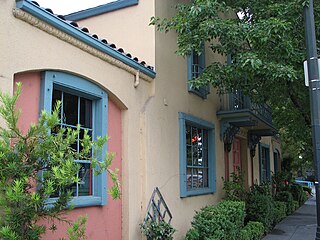
Petaluma and Santa Rosa Railroad was a 600 volt DC electric interurban railway in Sonoma County, California, United States. It operated between the cities of Petaluma, Sebastopol, Forestville, and Santa Rosa. Company-owned steamboats provided service between Petaluma and San Francisco.

The San Francisco, Napa and Calistoga Railway, later briefly reorganized as the San Francisco and Napa Valley Railroad, was an electric interurban railroad in the U.S. state of California.
This article lists the railroads and a timeline of railroad history in Solano County, California.
Fresno Traction Company operated electric trams in Fresno, California, from 1903 to 1939. Earlier horsecar tracks were improved and electrified under consolidated ownership which passed to Southern Pacific Transportation Company operation in 1910. A separate Fresno Interurban Railway shared some lines along Fresno city streets.
References
- ↑ Profile of Muni's First Publicly Owned Streetcar.
- ↑ Stindt, Fred A. (1985). The Northwestern Pacific Railroad Volume Two. Fred A. Stindt. p. 124. ISBN 0-9615465-0-6.
- ↑ Cal Cable Roster